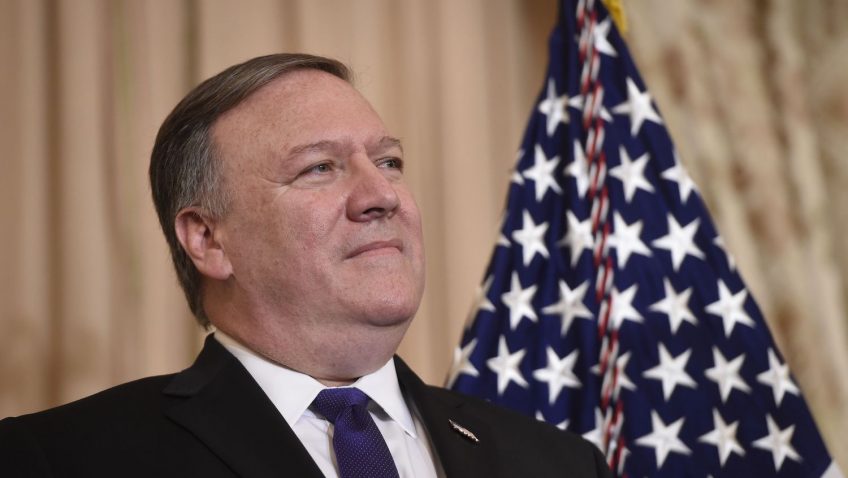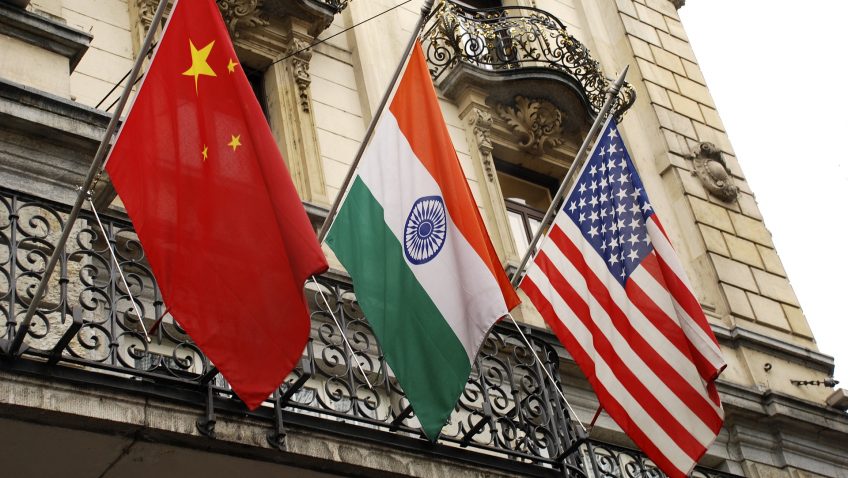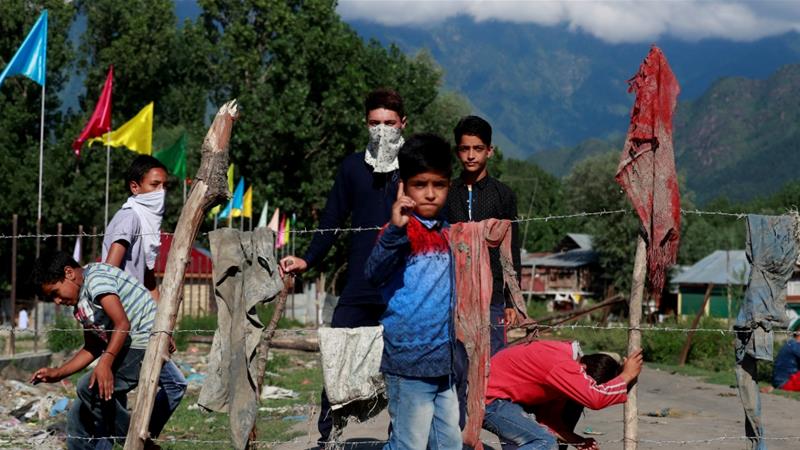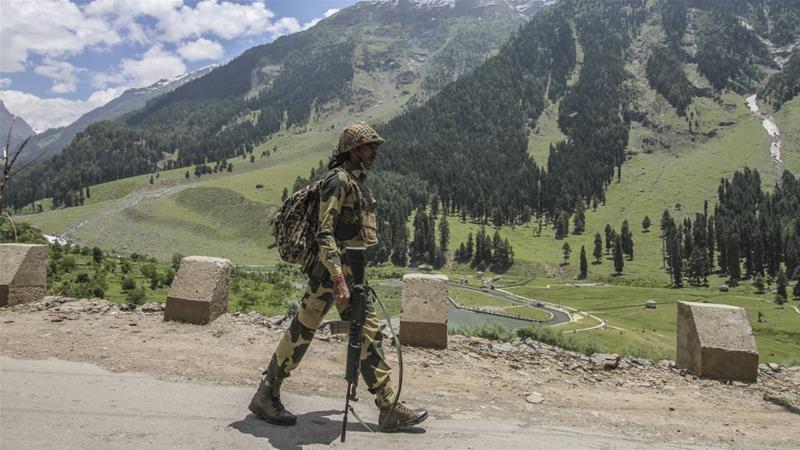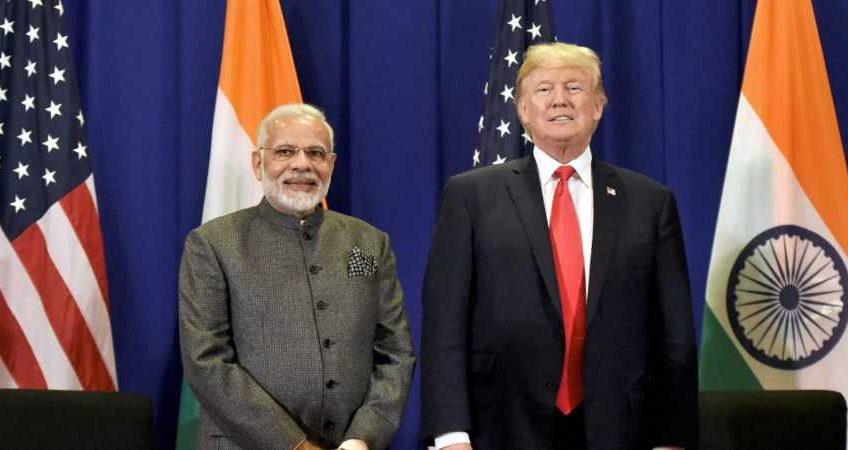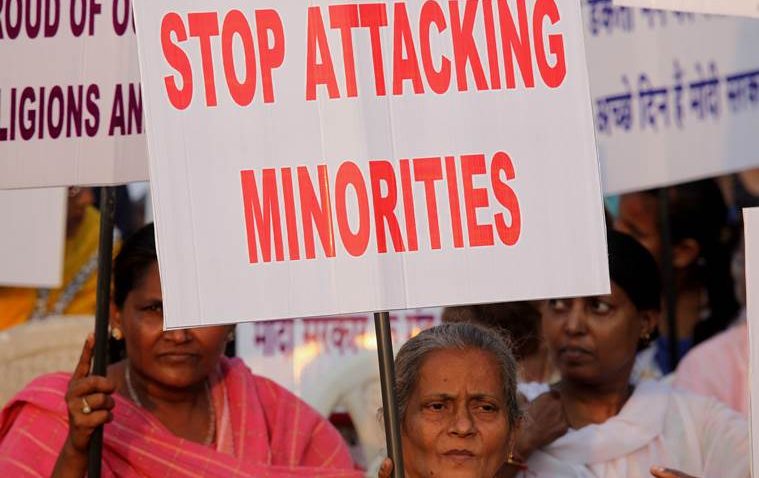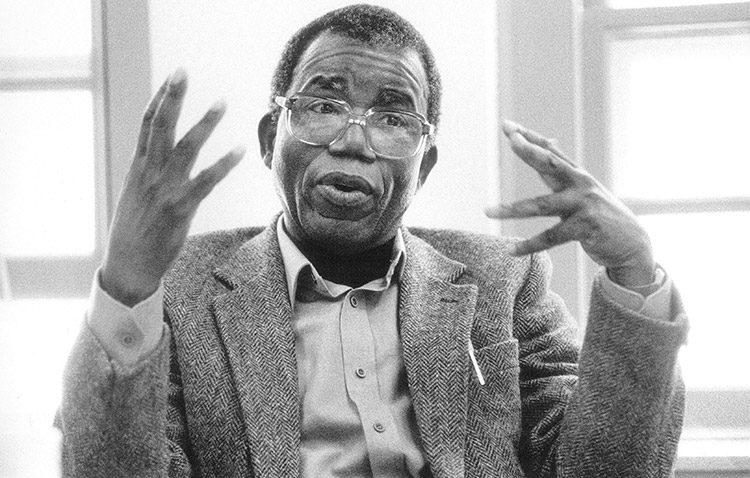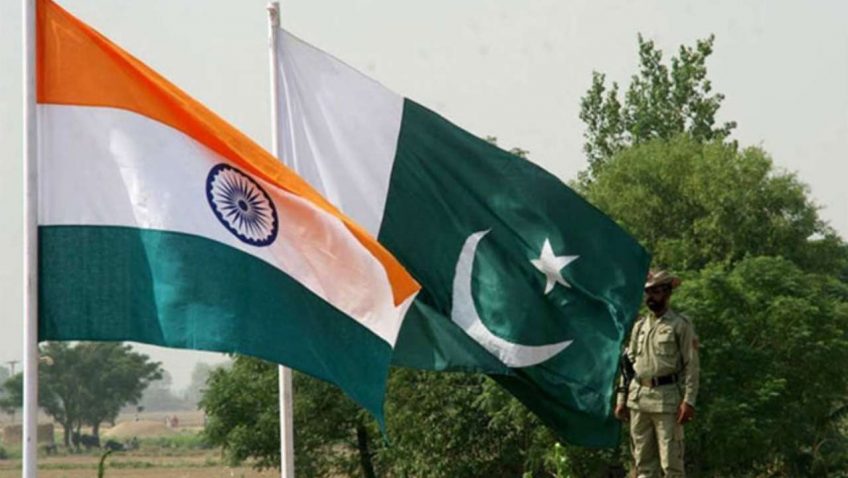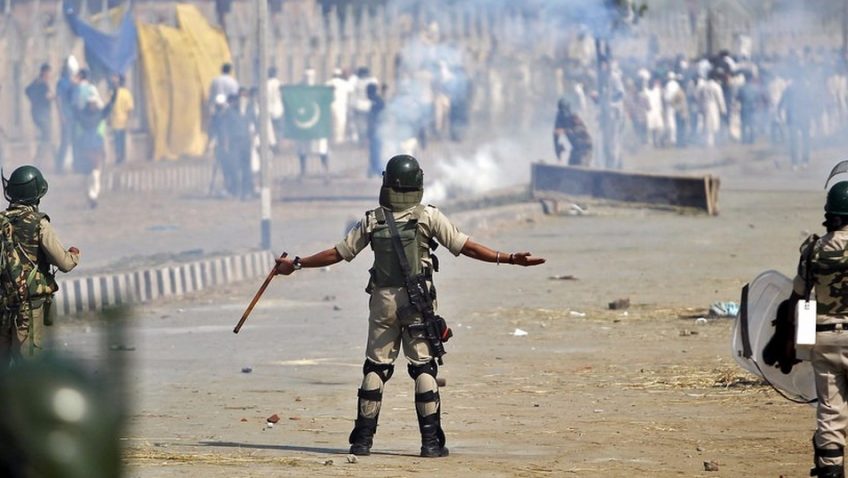The American fiasco in the Middle East, coupled with the bequeathed legacy of Trump’s era, is posing tremendous challenges to the new American administration. Though the latest Russian invasion of Ukraine and the ongoing horrendous chaos in the global economy are distracting Washington from China, the Biden’s administration so-called “Indo-Pacific” strategy entails that Asia remains a top priority to Washington. In one of his latest works titled “Destined for War”, Graham Allison examines whether China and the US are heading towards a prolonged war. Although the recent lockdowns in China are presenting challenges to it is goals of taking over the US as the biggest economy in 2030, Beijing’s military activities in South China continue to puzzle the Biden’s administration.
Geopolitically speaking, the rise of China has prompted US policy makers to alter their prolonged “Asia-Pacific” strategy to deal with the so-called Chinese threat .Coupled with the formation of trilateral security alliances, including the AUKUS, the so-called “Indo-Pacific” strategy aimed at thwarting Beijing’s growing influence from the Western Pacific to the Indian Ocean. The released document says explicitly that Washington is expected to focus on “every corner” of the region. Yet, despite this, the so-called “Indo-Pacific” strategy is not confined to containing China only; it aims to develop a new security architecture in Asia as well.
The concept of “free and open” Indo-Pacific, therefore, offers an ideological and political justification for the American deployment in the region. It is an ideological and political construct that aims at preventing the rise of China, while securing the American interests in the “imagined” region. Last Month, Kurt Campbell, the U.S. National Security Council coordinator for the “Indo-Pacific”, said that America is more likely to witness a strategic surprise in the Pacific region. In addition to that, the latest security pact between China and Solomon Islands has provided American and Australian policy makers with the opportunity to further securitize the region.
The aim of this paper, however, is not to examine China’s actions and policies, but to assess the applicability of the post-structuralism approach in the case of the Indo-Pacific. In other words, the aim of the paper is to examine how the “Indo-Pacific” was imagined and constructed through political discourse.
Instead of dealing with the region as naturally given, the paper questions the “naturalness” of the region. Since Post-Structuralism and critical geopolitics are interested in studying the relationship between geographical knowledge and power, it has become increasingly necessary to study how the so-called “Indo-Pacific” region is developed.
To achieve this goal, the paper relies on critical geopolitics approach to examine how the region was “imagined” and securitized. Hence, the paper argues that the “Indo-Pacific” region is an outcome of political construction and imagination to build new (American) security architecture in Asia.
Knowledge-Power Nexus
Although Post-Structuralism is an approach that is originally developed in sociology and literature, it is still widely utilized in studying international relations, especially by scholars of the critical school in IR. Though it does not provide it is readers with a “world view”, post-structuralism remains an important tool of analysis in IR. Critical Geopolitics as a strand in Post Structuralism, questions geographical assumptions and how they are dealt with, especially within policy circles.
The so-called concept of “Indo-Pacific” is widely used in many countries of the region, including Japan and Australia. Though the focus of the paper is on American imagination of the Indo-Pacific, it is important to, at least, note that countries in Asia have interests as well in developing biased knowledge of geography.
Although the term “Indo-Pacific” was not explicitly used, until very recently, maritime strategists, such a Gurpreet S. Khurana in India, criticized the strategy of the “Asia- Pacific” for ignoring the growing importance of involving India into a new strategy that aimed at containing China. According to Khurana, East Asia and New Delhi should enhance their political and economic alliances across the “Indo-Pacific”.
Likewise, Shinzo Abe, the Japanese Prime Minster, gave a speech before the Indian parliament in August 2007, arguing for the growing importance of enhancing relations between the Asia Pacific and South Asian regions. Though he did not explicitly use the term of “Indo-Pacific”, it was clear that there was a general urge to alter Washington’s policy regarding the containment of China.
President Biden perceives the so-called Chinese threat as a factor that endangers the “democratic” and “liberal” Indo-Pacific order. Hence, by portraying the struggle between China and the US as a prolonged struggle between democracy and authoritarianism fits the assumption of Post-Structuralism in IR. According to this school of thought, politics in IR is treated as black or white. The securitization and political imagination of the Indo-Pacific, therefore, are outcomes of this binary division and subjectivity.
Issue of Representation:
Based on the current literature, there are two reasons why the political construction of the so-called “Indo-Pacific” region seemed a plausible option for the Biden administration. Firstly, the American administration realized the horrendous military and political activities of Beijing from the Western Pacific to the India Ocean. Secondly, the Biden administration realized the tremendous importance of incorporating India into the new security architecture. This explains why India is incorporated into the Quadrilateral Dialogue (QUAD), which is formed to establish New Delhi as the new “security provider” in the region.
Although New Delhi’s imagination of the region is an extension of it is “Look East Policy”, India’s strategy is more cautious than Australia and Japan. Though it is part of the “QUAD”, it has been unable to determine whether it is imagination of the Indo-Pacific is aimed at excluding China. Nonetheless, the political imagination of all the “Indo-Pacific” in the Indian, American, and Australian circles entails that world maps are adjusted to fit strategic concerns of the respective time.
Hence, it has become clear that “mental maps” are all about power relations; it is the language of the “powerful”. The so-called “Indo-Pacific”, which is an outcome of political construction, aims to privilege certain nations, including Australia, Japan, and India, over the others. Therefore, it seems that we cannot have a permanent or balanced understanding of the world. In other words, policy makers asses the growing threats in a specific area and they employ the suitable strategy, which includes securitizing the “imagined” region in order to serve their strategic interests.
In one of his latest statements, Antony Blinken, US Secretary of State, said that the so-called “Indo-Pacific” is expected to shape the “trajectory” of the world in the 21st century. During his speech in Jakarta, Indonesia, Blinken said that Washington will adopt a strategy of “deterrence” to promote “peace” and ‘“stability” in the Indo-Pacific, arguing that threats are evolving dramatically in the (imagined) region.
During her latest visit to Singapore, Kamala Harris kept warning her counterparts of the Chinese “incursion” in the region, arguing that Beijing’s policies are intimidating. Again, she repeated the word “free and open” Indo-Pacific, stressing on the importance of enhancing relations with Washington’s allies to defend the “imagined” region. It has become clear; therefore, that Biden’s so-called “Indo-Pacific” strategy is a continuation of Donald Trump’s designation of China as a foe.
According to South China Morning Post, a journal based in Hong Kong, White House officials started using the term of “Indo-Pacific” during Trump’s presidency. It was an attempt to distance the Trump administration from Obama’s “Pivot to Asia”. Biden’s decision to officially use the concept, therefore, entails that the term is becoming the new “normal” in Washington’s approach towards the “imagined” region.
Yet, Biden’s strategy differs in the sense that it puts emphasis on “integrated deterrence”, and instead of constraining economic relations with the region like Trump did when he left the Trans-Pacific Partnership, Biden initiated an economic Indo-Pacific framework. Though the new strategy prompted fierce debate in Chinese policy makers, it is still adopted by the US, Australia, Japan, among others.
In his article “Maritime politics as discourse in the Indo-Pacific”, Tim Summers, an Assistant Professor and Research Fellow at Chatham House, argues that China has always been placed at the center of the geopolitical discourse within the American policy circles. He says that the Chinese threat itself is part of the evolving the geopolitical discourse in Washington.
Besides, Summers (2021) believes that maritime space, politics, and boundaries are parts of the geopolitical discourse in Asia. Therefore, Summers argues that geopolitics is material and ideological at the same time; it is a process through which knowledge is produced and internalized. By analyzing the map of the South China Sea adopted by the West, one can easily find an orientalist and biased representation of China in this area. The usage of pink or red colors in areas that are witnessing Beijing’s rise provides a virtual representation of China as a penetrator of the Sea area.
To conclude, there is a limited literature written on the political imagination and construction of the Indo-Pacific. Yet, it has become increasingly necessary to study this “imagined” region, especially in times when the US is shifting it is attention towards China. In contrary to the prevailing analysis, the Russian invasion of Ukraine is less likely to distract the Biden’s administration from China’s activities in the Indo-Pacific. In the midst of political chaos in the US, China is initiating security pact with Solomon Island to ramp up it is influence in the imagined region.
The paper tried to apply post-structuralism and critical geopolitics on the case of the Indo-Pacific, with a special focus on issues of false representations, subjectivity, and binary divisions. Yet, given the limited literature, the author of the paper advice future scholars to thoroughly examine the written and spoken statements in the US regarding the Indo-Pacific. Analysts are not exaggerating the threats of War; it might happen in the not-too-distant future. The fact that countries like Australia are allying with the US, says a lot about the growing polarization in the so-called Indo-Pacific. Analysts are not exaggerating the threats of war when they say that China is more likely to kick Washington out of the South China sea; it might happen in the not-too-distant future
Historically, India and US had a very cold relationship, mostly due to US Support to Pakistan. But after George W. Bush came into power, India and US have been on good terms and the Nuclear Sanctions imposed by Bill Clinton in 1998 were pulled off through India-US Nuclear Deal in 2008, the bilateral trade between India and US tripled between 2004 and 2008.
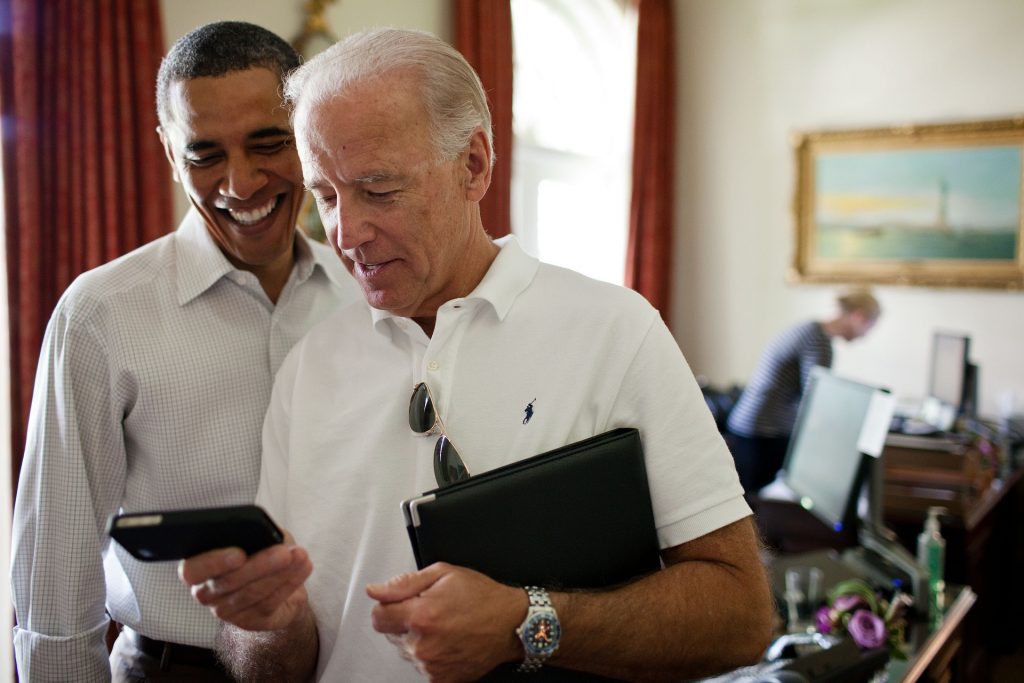
The tenure of Barack Obama was the golden age for India-US relations on all levels as US formally started supporting India’s bid for a permanent seat in UNSC and also for admitting India into Nuclear Suppliers Group and Weapons Trade has also increased exponentially due to common geopolitical interests and this increased even more after Osama bin Laden was caught hiding in Pakistan in 2011. What this also meant is that major incidents like the Devayani Khobragade incident failed to cause any long-term issues between the nations while it would have earlier
Barack Obama addressing Indian Parliament in 2010
India was classified as a major non-NATO ally in 2004 but the offer was rejected by India due to the policy of Non-Alignment. However after Narendra Modi came into power in 2014, India has adopted a policy of Multi-Alignment going for strong relations with rival nations like USA and Russia, Iran and Saudi Arabia etc and that also meant even stronger relations with USA in the face of Pax Sinica which will affect both India and US adversely which resulted in the Quadrilateral Dialogue between India, US, Japan and Australia which started in 2007 and was rejuvenated in 2017 and more importantly, Logistics Exchange Memorandum of Agreement was signed in 2016 which allowed both nations to use each other’s bases for minor uses thereby classifying India as a strategic partner of US.
But Donald Trump’s presidency has been a whole another affair, the problem with Trump is that he is a businessman who only looks to exploit other nations to benefit him in the short run and is extremely averse to working together to attain long-term goals. While he has no problem praising India and more importantly, Narendra Modi, it is only an effort to woo Indian-American voters who are overwhelmingly Democrats and this has paid rich dividends for him as he is now viewed favourably among Indian Americans and Indians.
Donald Trump speaking at Motera Stadium, Ahmedabad
But beyond the PR, his policies are pretty much disastrous for Indian Interests in the long term. His numerous trade tariffs and barriers have hurt Indian industries and he doesn’t hesitate to use vile words like Tariff King to describe India who is only trying to exercise her rights and America’s lax attitude to Geopolitics also gives a free hand to China who has been continuing with debt trap diplomacy in South Asia which is contradictory to Indian Interests in the region. Trump’s antics to cut legal immigration and strictening H1-V visa rules have also hurt many Indian citizens. He has also forced India to not buy oil from Iran because he doesn’t like the Nuclear Deal his nation signed which makes India too dependent on Arab States for oil. His decision to pull out of Afghanistan by de facto legalising Taliban will be catastrophic to India as Taliban is directly or indirectly the instigators of Terror in Kashmir.
But this doesn’t mean that all Democrats see India in a favourable view either, many Democrats on the Progressive wing like Bernie Sanders and Kamala Harris don’t seem to be great fans of India, and more importantly, of the current government and Bernie Sanders is especially concerned about Kashmir, while the merit of their statements is a whole another question, what can be agreed upon is that it is not good for India in any manner and reduced involvement of US in World Affairs which is flaunted by many progressives will do harm for India.
But the presumptive opponent of Trump, Joe Biden, is a different figure, he was the Vice President of Barack Obama and his stance on Foreign Policy pretty much resembles that of Obama’s which is definitely good news for India. If he wins elections, it is likely that legal immigration to US will be increased and many dumb trade barriers will be removed thereby helping Indian Industries and it is likely that US will finally start facing China head-on in the World Stage instead of running away which is what Trump is trying to do, so in short, expect less PR events like Howdy Modi and Namaste Trump as most Indian-Americans are already Democrats and expect more on substance like closer co-operation between companies, education sector etc which will be good for Indians as a whole, not just the leaders and their parties.
Residents in Soura neighbourhood of Srinagar, Indian-administered Kashmir, plant barricades to keep security forces out.
For more than a week, the young men of Soura, a densely-populated enclave in Indian-administered Kashmir’s main city of Srinagar, have been taking turns to maintain a round-the-clock vigil at the entry points to their neighbourhood.
Each of the dozen or so entrances have been blocked with makeshift barricades of bricks, corrugated metal sheets, wooden slabs and felled tree trunks. Groups of youths armed with stones congregate behind the biggest obstacles.
Their aim: to keep Indian security forces, and particularly the paramilitary police, out of the area.
“We have no voice. We are exploding from within,” said Ejaz, 25, who, like many other residents in Soura interviewed by Reuters news agency, gave only one name, saying he feared arrest.
“If the world won’t listen to us too, then what should we do? Pick up guns?”
Soura, home to about 15,000 people, is becoming the epicentre of resistance to the government’s removal on August 5 of the partial autonomy enjoyed by Jammu and Kashmir, the country’s only Muslim-majority state.
The enclave, which has effectively become a no-go zone for Indian security forces, is now a barometer of the ability of Prime Minister Narendra Modi’s Hindu nationalist government to impose its will in Kashmir after its dramatic move.
The change, the government said, was necessary to integrate Kashmir fully into India, tackle corruption and nepotism, and speed up its development, which Modi says is the key to securing lasting peace and defeating “terrorism”.
A neighbourhood street is blocked with tree branches by Kashmiri protesters during restrictions in Srinagar [Danish Ismail/Reuters]
In Soura, it is hard to find anyone who supports Modi’s move. Many of the more than two dozen residents interviewed by Reuters over the past week referred to Modi as “zaalim”, an Urdu word meaning “tyrant”.
The constitutional change will allow non-residents to buy property in Jammu and Kashmir and apply for jobs in local government.
Some Muslims in Kashmir say they fear that India’s dominant Hindu population will overrun the lush state at the foot of the Himalayas and that Kashmiris’ identity, culture and religion will be diluted and repressed.
“We feel like we are guarding the LoC here,” said Ejaz, referring to the Line of Control, the highly militarised de facto border between the Indian and Pakistan-controlled parts of Kashmir.
For decades, Kashmir has been a source of friction between nuclear-armed India and Pakistan. Both nations claim the region in full and have fought two wars over the territory since 1947.
Residents in Soura say dozens of people have been injured in clashes with the paramilitary police over the past week. It is unclear how many have been detained.
A spokesman for the Jammu and Kashmir government declined to answer questions from Reuters.
The Indian government’s Home Ministry did not return calls and emails seeking comment.
The Indian state of Jammu & Kashmir (J&K) is in lockdown after the government revoked a special status granted to the troubled region.
On Monday, Interior Minister Amit Shah told India’s parliament that the federal government would scrap Article 370, a constitutional provision that grants special status and allows the Indian state of Jammu & Kashmir to make its own laws. The order was subsequently approved by the Indian President.
CNBC takes a look at what this means for Kashmir and for the Muslim-majority state’s relationship with India.
What is Article 370?
Article 370 of the Indian constitution carves out a special status to the state of J&K. It also limits the Indian parliament’s power to make laws for the state. In effect, the special status, which is described as “temporary” allows the state of Jammu & Kashmir to have its own constitution, its own flag and take decisions except for any matter that is related to defense and foreign affairs. The temporary provision was included in the constitution on 17 October, 1949. This special status dates back to the end of British rule in India in 1947 when Maharaja Hari Singh of the then colonized state of Jammu & Kashmir signed a Treaty of Accession for the state of J&K to join the Indian side.
Meanwhile, Article 35a, which was added to the constitution in 1954 under Article 370 gives the state of Jammu & Kashmir the right to decide who its permanent residents are. The clause further gives special rights to residents in government jobs, when buying property in the state and for educational scholarships among others.The state defines its permanent residents as those that are “born or settled within the state before 1911 or after having lawfully acquired immovable property and resident in the state for not less than 10 years before that date.”
The law bans non-permanent residents from settling in the state, buying land, and taking government jobs or scholarships.
Why is the Indian government revoking Article 370?
Prime Minister Narendra Modi’s ruling party had pushed for an end to Kashmir’s special constitutional status, arguing that such laws had hindered its integration with the rest of India. India’s government wants to strengthen its influence over its only Muslim-majority region.
In the run up to the most recent elections in May this year, Modi’s Bhartiya Janta Party (BJP) had promised a firm policy action to bring peace in the Jammu & Kashmir region. “In the last five years, we have made all necessary efforts to ensure peace in Jammu and Kashmir through decisive actions and a firm policy. We are committed to overcoming all obstacles that come in the way of development and providing adequate financial resources to all the regions of the state. We reiterate our position since the time of the Jan Sangh to the abrogation of Article 370,” according to the manifesto.
On Monday, Interior Minister Amit Shah introduced the measure in parliament amid massive protests from the opposition as well as regional parties in J&K. Opposition parties have condemned the government’s proposal, calling it “undemocratic.” Shah also said the state will be divided into two union territories – Jammu & Kashmir, which will have its own legislature, and Ladakh, which will be ruled directly by the central government and will have no legislature of its own. A union territory is a type of administrative division in India. Unlike the states of India, which have their own governments, union territories are federal territories governed directly by the main government.
What’s the situation on the ground?
India has deployed tens of thousands of troops across the Kashmir valley in anticipation of a backlash of the revoke. Indian authorities banned public movements, shut down schools and colleges indefinitely and put two former chief ministers of J&K — Omar Abdullah and Mehbooba Mufti — under house arrest ahead of the announcement.
The two leaders took to Twitter to express their disappointment over the decision and warned of consequences. Indian media reports suggest that mobile internet services have been suspended in Kashmir Valley and Satellite phones were being used by security officials.
Critics on Twitter have condemned the move, calling it “authoritarianism.” Indian-author Ramachandra Guha blamed the government for taking action without a proper debate.
What is Pakistan’s response to this?
On Monday, the Pakistan government strongly condemned India for taking “illegal steps” in its decision to revoke special status for Kashmir. This according to Reuters, citing a government statement. The Pakistan government also warned that it will “exercise all possible options.”
“As the party to this international dispute, Pakistan will exercise all possible options to counter the illegal steps,” Pakistan’s foreign ministry said in a statement.
How Kashmir got here?
India and Pakistan’s conflict over the mountainous region of Kashmir dates back to 1947 when both countries became independent from British colonial rule.
The entire subcontinent was partitioned into Hindu-majority India and Muslim-majority Pakistan, which led to a mass displacement as people migrated from one country to the other. Outbreaks of communal and religious violence killed hundreds of thousands of people in the subcontinent during that time.
Jammu and Kashmir was a former princely state where a large number of people were killed and others were driven away by the violence during the partition. Since then, India and Pakistan have fought multiple wars over the region — both countries claim the region in full but control only parts of it. Many have raised concerns over violence and human rights abuses in both India-controlled Jammu and Kashmir, as well as in Pakistan-controlled Azad Kashmir and Gilgit-Baltistan region.
This excellent article was originally found on CNBC here’s the link towards the source : https://www.cnbc.com/2019/08/05/article-370-what-is-happening-in-kashmir-india-revokes-special-status.html
India has emerged itself as a big power, with the Make In India Initiative seeking to make India a major manufacturing hub, and is emerging as a major hub in the technology sector.
A United States – India alliance is not only good for the economy of the United States, but also for the national security of the United States.
One reason for India’s large economy is because it sits between the routes between the Middle East and the Far East. Ships going through the Suez Canal pass by India on their way to Singapore. West of India is the Middle East, still a hotbed for global jihad activity. North of India is China, a country currently threatening American hegemony in the Pacific Ocean, and under international scrutiny for it’s trade policies and checkbook diplomacy. East of India is Singapore, a major economic power and a country in a region that has received a lot of support.
India is surrounded on three front, and water on the fourth. If India falls, it will fall to these forces, and cause a global chain reaction that will eventually reach its way to the United States.
But there is a more practical reason as to why the United States needs an alliance with India: Afghanistan and the events of September 11, 2001.
The United States invaded Afghanistan to drive out Al-Qaeda, which was granted safe harbor by the Taliban, whose creator and biggest backer is Pakistan, arch rival of India. And Osama Bin Laden was eventually found in Pakistan, next to a key Pakistani military instillation, raising suspicions of Pakistani/ISI collaboration.
The War on Terror has forced Washington and New Delhi together, the rise of China has brought Washington and New Delhi together, the global economy has brought Washington and New Delhi together. And for the future of both powers, they must remain together.
India and Australia, in 2008, signed a ‘Joint Declaration on Security and Cooperation’[1] which wished to bring together the strategic perspectives of both the nation states through a ‘cooperative security framework’. One of the key features of this declaration was increased cooperation in the maritime domain at a strategic level. For Australia, the Indian Ocean region has a prominent place in its strategic calculations, having the longest coastline and largest area of maritime jurisdiction, the emergence of newer nation states within Indian Ocean has made its role greater in the region.
India, on the other hand, focuses on the Indian Ocean Region as being a ‘strategic bridge with the nations in its immediate and extended maritime neighbourhood.’[2] India has since the 2008 terror attacks in Mumbai, refocused its maritime policy and more particularly within the region. Its increased emphasis on the protection and assurance of ‘safe passage’ in the region comes from two factors; one is China’s increased presence and linkages with other Indian Ocean Littorals and the second, is India’s ambition to be a ‘net security provider’[3] to the region. The nation is also increasingly looking towards expanding its influence in the fast emerging construct of an ‘Indo-Pacific’ region. The ‘QUAD’ (Quadrilateral Security Dialogue) was a key enabler in expanding India-Australia partnership, within the Indian Ocean and the ‘Indo-Pacific’.
Geographically, Australia has approximately 86 million square km wide Exclusive Economic Zone along with the surveillance and defence of the AEEZ (Australian Antarctic EEZ) within the region[4]. The nation’s responsibility to provide safe passage and navigation to ships and submarines could be one of the reasons why an increasingly aggressive China within the Indo-Pacific region seems to be of great strategic concern. A brief assessment of Australia’s maritime strategy gives one an understanding of the need of a comprehensive strategic outlook’s for the country to effectively pursue its national interest in the region.
There is however seen, a lack of coordination between national and state level instrumentalities wherein responsibility of Australian policy makers towards its maritime affairs seems to be largely ignored with some analysts calling it ‘sea-blindness’[5]. In 2005, the then Chief Admiral of the Royal Australian Navy, Vice Admiral Chris Richie remarked on the ‘ambiguous place of the seas’[6] in Australian National life, urging for a re-examination of Australia’s land based identities.
India on the other hand is marking the 21st century as the ‘century of the seas’[7] for itself. The Indian Navy is central in promotion of the country’s national interest and security in the maritime domain. The country’s maritime security strategy, under the present leadership seems to be carrying a larger ‘strategic angle’ and wishes to embody an ‘Indian naval vision’ for the region. Former Admiral and Chief of the Indian Navy, R.K. Dhowan remarks on three significant developments in the nation’s maritime security architecture[8]; First is India’s move from a ‘Euro-Atlantic’ to an ‘Indo-Pacific’ focus which seems to have largely repositioned the country’s global economic and military power within the region. Second, is the recognition of ‘new and emerging threats’ in the form of piracy and terrorism which has made India to relook its offshore and coastal security. Third is an acknowledgement on the part of the administration in enabling the Indian navy to perform a more strong and enhanced role in the country’s maritime security.
Australia has been one of the most vocal supporters to India’s ambition of being a ‘net security provider’ to the region. Australia aims to create a deeper maritime relation with India so as to present it as a counterbalancing force against China. The island state wants to avoid itself and the region to get embroiled in a confrontation between US and China and thereby find it picking sides. The country has been subtly stepping up its security cooperation with India, through extensive maritime exercises such as the ‘Indo-Pacific Endeavour’ which was hosted in March 2019,across the Indo-Pacific region and hosted at states of Vishakhapatnam and Chennai in India specifically[9].
India’s policies towards the Indian Ocean have a global perspective and appeal that could work in Australia’s favour as they continue to deepen and establish more meaningful bilateral security arrangements so as to ensure security of the Indian Ocean. There are however, some challenges to a fruitful maritime cooperation between both the nation states. The increasingly aligned intentions and interests of both the nations have been conducive in establishing a dialogue in academic circles of moving the partnership between India and Australia to a more concrete phase. Australia’s efforts to woo India have been more than evident whereas India still chooses to take measured steps towards enriching its relationship with the country. In 2011, Australia removed its ban on Uranium sales to India after years of its hesitation, showing clear intentions of the nation[10].
The ‘QUAD’, even when seems to have re-energised the spirits of the ‘maritime democracies’ of the Indian ocean states and the ‘Indo-Pacific’ states, has largely been a talking shop giving the reflection of the dialogue having more rhetoric than action. Another challenge for Australia is India’s insecurity as a nation wherein it believes that visibility is vulnerability and therefore feels that by closely aligning itself with US and its allies it may disturb an already delicate maritime chessboard of the Indian Ocean region and trigger the dragon. Apart from this, India also fears that Australia, which has been a strategic ally to the United States for a very long time may eventually isolate India in order to promote US predominance within the Indian Ocean leaving it high and dry.
The two nations therefore have vast opportunities to explore so as to ensure greater maritime cooperation. Joint exploration efforts in the region can be one of the ways by which a stable growth of both the nations’ economies can be benefitted. Participation of both the nations in institutions such as IORA( Indian Ocean Rim Association) and IONS(Indian Ocean Naval Symposium) can also be a catalyst in deepening relations between the two. However, different traditional instincts about security collaboration and a fear on the part of both the states to not instigate China is becoming a major hindrance in an otherwise fated marriage between both the nation states.
[1]‘PA5009 India-Australia Joint Declaration On Security Cooperation’, Australia High Commission, November, 2009, See website, https://india.embassy.gov.au/ndli/pa5009jsb.html
[2]India and the Indian Ocean: A Briefing’, Institute For Defence Studies and Analyses, April,2016, See Website, https://idsa.in/idsanews/india-and-the-indian-ocean_skundu
[3]‘ Ensuring Secure Seas: Indian Maritime Security Strategy’, Indian Naval Strategic Publication(NSP)1.2, Ministry of Defence, October,2015, See Website, file:///C:/Users/hp1/Documents/admin%20material/geopol/semester%20two/maritime/Indian_Maritime_Security_Strategy_Document_25Jan16.pdf
[4]‘Inquiry into Australia’s Maritime Strategy’, Joint Standing Committee on Foreign Affairs , Defence and Trade, The Australian Centre for Maritime Studies, November,2002, see website, http://www.tamilnation.co/intframe/indian_ocean/australia_centre_for_maritime_studies.pdf
[5]Michael Evans, ‘The Third Way: Towards an Australian Maritime Strategy for the 21st Century’, The Australian Army, Commonwealth of Australia Army 2014, See Website, https://www.army.gov.au/sites/g/files/net1846/f/thethirdway_evans.pdf
[6]Ibid
[7]n.3
[8]n.3
[9]Sidhant Sibal, ‘Australia Welcomes India’s Leadership in the Indian Ocean: Foreign Minister Marisse Payne’, DNA India, January, 2019, See Website, https://www.dnaindia.com/india/report-australia-welcomes-india-s-leadership-in-indian-ocean-foreign-minister-marise-payne-2706152
[10]Fredric Grare, ‘India-Australia Strategic Relationship: Defining Realistic Expectations’, Carnegie Endowment for International Peace, March, 2014, See Website, https://carnegieendowment.org/files/india_australia_strat_rel.pdf
But it wasn’t an isolated case.
According to Human Rights Watch (HRW), Hindu vigilante groups have killed dozens of people in recent years, many of them Muslims, for allegedly slaughtering or transporting cows — an animal that is considered sacred by many Hindus.
The attacks have sparked concern about the spread of violent Hindu nationalism since Indian Prime Minister Narendra Modi and his right wing Bharatiya Janata Party (BJP) came to power in 2014.
Critics say the presence of a Hindu nationalist government in Delhi has encouraged vigilantism by their hardline supporters against cattle traders, especially Muslims, a minority in India. Even minority groups within the Hindu community, such as lower caste Hindus previously known as “untouchables,” have faced violence from hardline nationalists.
“There is fear. There was one incident and so we fear that there will be another,” said Suraj Pal, a farmer in Khan’s village, Kolgaon.
Literature indubitably is the reflection of life and its animadversion as well as paints a realistic picture of society and its institutions. Suchlike is the predicament of African novelist Chinua Achebe’s 1966 novel “Man of the People” which talks of corrupt government leaders ruling an unnamed African country who hegemonize its citizens to amass support for their positive and unacceptable works both. They are prosperous by cause of prejudiced role media plays and absolves them from accountability while it demonizes any kind of opposition. Furthermore they attempt to silence the opposition either with the almighty dollar or the assassinations.
In the novel, the protagonist Odili is disillusioned in 1960 when the Prime Minister refuses to cut off coffee prices proposed by economic experts for the good of the country. Two-third of the cabinet upholds the decision and the one-third who do not, are called names oftentimes. The experts are barred to speak by rapacious ministers and their supporters. The ministers contending the move are served blows by angry mobs and labeled traitors. The mobs are never in mood to listen to any reason for the influence of Prime Minister’s speech. The press plays its part by publishing contorted versions of the opposition’s take on the matter. Rebellious ministers are driven out and Mr. Nanga (another character in the novel) is voted in Member Parliament. He within himself is an epitome of corruption. Together with another minister Mr. Koko, Mr. Nanga bribes Odili and his friend Max to withdraw their newly formed political party CPC from upcoming elections and subsequently Mr. Koko murders Max for he accepts money and continues the campaign. The villagers who aid CPC are penalized by Mr. Nanga’s party with the removal of “Rural Water Scheme” and it’s only after their reassured support, some parts of the scheme return to village. The novel ends with a military coup divulging the corruption of government and initiation of inquiries against its ministers.
What Achebe wrote about in 1966 is a pathway the nation of India noticeably walks upon after 2014 with the rise of Bharatiya Janata Party. Although the party claims zero tolerance towards corruption, many leaders with allegations of corruption against them find it a safe heaven. Besides, the discontinuance of survey which provides the rate of unemployment, opacity in Rafael deal, demonization, dismissal of criminal case of multiple hate speeches against Uttar Pradesh CM Yogi Adityanath, use of tax payer funds for Brahmin only facility by BJP MP in Jammu, bail to VHP leader Atul Vadia accused in Gulberg society massacre, suspension of an IAS officer who checks Prime Minister’s chopper and cases of money laundering against its various leaders are testimonials to the ecumenical corruption in the party. The conspicuous hypocrisy of the government is its adjudication to ban beef at home and top the exporters list each year. The mockery is its very own ministers in eastern India promise quality beef in exchange of their win in elections while it’s avaricious Ministers instigate and venerate their supporters in the northern and central India who lynch people on mere rumors of stealing cows or carrying beef. The victims and each and every one who opposes this barely condemned vicious cycle of violence is labeled a traitor, anti-national, anti-Hindu and asked to go to Pakistan. This fractured political discourse matches exactly to what Achebe talks of in his novel. Either you’re with the hegemonized mobs or an anti-national, a traitor. Nobody has the right to question government or its supporters for whatever they do.
The business Indian media does is exposed by commendable investigation carried out by “Cobra Post” (available on YouTube) which brings to notice the biased and venal nature of Indian media outlets who for a hefty sum are ready to carry soft Hindutva propaganda (manipulating Hinduism) initially to hardcore Hindutva ideology (the ideology of BJP) subsequently on their TV shows and newspapers. Before elections when the works of BJP are to be aired, some media outlets in India broadcast the reign of previous Congress government and their scandals exonerating the ruling party in a way similar to that of Mr. Nanga in the novel who prevents editors from publishing articles critical of their government. The shift in the trend of intial question, from “What work your government is doing or has done?” to “How you manage to do this much work?” asked to the leaders is witness to the fact that the ratings of press freedom in India are not aimlessly touching the ground. The fine example of demonization of opposition is the contortion of election manifesto of Congress by Indian media outlets pointing towards free electricity to Mosques and Churches while deliberately veiling the part of free electricity to Temples and referring to the issue of scholarship to Muslim students for overseas education and deliberately hiding the word “poor Muslim students” and the mention of SC, ST, EBC and OBC students. Not to forget the death threats to Ravish Kumar, Dhruv Rathee and the murder of Gauri Lankesh, all prominent critics of the ruling party accommodate in the cycle of silencing opposition.
Beyond doubt, common Indian masses will find theirselves in the shoe of the villagers penalized in the novel for supporting CPC and not Mr. Nanga’s political party by reason of aggressive and sinister attitude of the leaders of BJP who forewarn voters to vote for them or encounter ceasing of the funds for Panchayats, no jobs, no water to drink and even the shift of sins upon the people who vote against them.
Achebe names not the country in his novel because he seemes to be suggestive of his relevance in the impending era and more than 50 years after the publication, we can say that Achebe’s Africa is modern India. This indeed is a political turmoil in juxtaposition to the situation in Achebe’s novel wherein the leaders hegemonize the citizens, get involved in corruption and create a discourse according to which catechization of government is an anti-national deed and deserves punishment either by the might or mob.
Hariz Aftab is a student of Masters Program in English Literature in University of Jammu and can be contacted at aftabhariz@gmail.com
In conflict resolution, Confidence Building Measures (CBMs) play a crucial role between the states. CBMs help create a conducive environment for resolution of conflictual issues. They, however, are not direct means of conflict resolution. The efficacy of CBMs is not limited to a rival state’s military affairs but it encompasses a broad range of areas ranging from social to cultural contacts to economic affairs between the states. They are a tool to augment the level of confidence and trust between the rival states (Zulfqar, 2013). In the modern day world, CBMs are a broadly acknowledged concept which includes an extensive variety of measures including economic, political and military arenas. According to the commonly held belief, CBMs initiated during 1970s in Europe in backdrop of confrontations between the West and the East. However, the process of CBMs was already in practice in various different parts of the world but it was not characterized necessarily as such.
For example, CBMs were practiced in the South Asian region since the partition of the Indian sub-continent. The cases in point can be traced from 1949 with the Karachi Agreement in 1949, the pact between Liaquat and Nehru in 1950 known as Liaquat-Nehru Pact, the Indo-Pak Border Ground Rules Agreement in 1960, the Indus Water Treaty (IWT) in 1960 which is said to have remained intact even during wars, the Tashkent Declaration in 1966 which was signed under the good office provided by the USSR and the Simla Agreement in 1972 (Salik, 2010). Zulfqar (2013) adds to this and argues that CBMs are not a new phenomenon between India and Pakistan. Pakistan and India signed various agreements between them to resolve their bilateral problems which they inherited from the partition. She quotes all the events as quoted by Salik (2010) and adds the Rann of Kutch Agreement of 1966 to the list of CBMs between India and Pakistan. She further argues that the terminology of CBMs was not applied to the agreements between the two before Brasstracks Crisis in 1987 which added nuclear dimension in the relationship between India and Pakistan (Zulfqar, 2013).
Confidence Building Measures between Pakistan and India
There are different types of CBMs between the two arch-rival neighboring countries – India and Pakistan. These CBMs can be differentiated in atmospheric and military and nuclear related CBMs.
The Military and Nuclear Related CBMs
According to Micheal Krepon, Co-founder of Stimson Center, the military and nuclear related CBMs between India and Pakistan can be differentiated in three categories: Constraint Measures, Communication Measures and Transparency Measures (Zulfar, 2013).
1. Constraint Measures:
The Constraint Measures may encompass: routine inspection to show compliance with agreements, establishment of demilitarized zones between states and abstaining from military activities (more of skirmishes) in bordering areas between the states. In order to establish a nuclear restraint regime with its neighboring rival India, Pakistan has been putting efforts in this context even before the overt nuclearization of both countries. Pakistan has proposed various proposals over the years including mutual acceptance of safeguards by International Atomic Energy Agency (IAEA), signing of Non-Proliferation Treaty (NPT) of 1967 simultaneously, creation of nuclear weapon free zone, signing of regional test ban treaty, bilateral inspection of each other’s nuclear facilities and joint declaration to renounce development of nuclear weapons. However, none of these proposals could succeed to get India’s affirmation. Moreover, in 1998, Pakistan proposed establishment of a Strategic Restraint Regime in the region to avoid the risk of nuclear war between the two nuclear powers. It was renewed in 2001 during disarmament conference in Geneva. Like previous proposals, this could also not materialize.
2. Communication Measures:
Communication measures would include creating communication among political decision-makers of the states in conflict and the establishment of hotlines is the most effective arrangement for conflict resolution or crisis management purposes. In 1971, hotline between the Director Generals of Military Operations (DGMOs) of Pakistan and India was established and it was decided after the 1990 crisis that the hotline will be used on weekly basis between the DGMOs of both the countries. Besides this, a new hotline was created between the foreign secretaries of Pakistan and India in 2004. It has been observed that hotlines between the two countries remain satisfactorily functional only during the peacetime but during crisis they remain dysfunctional. However, it remained functional during Kargil Conflict in 1999 and the border confrontation in 2001-02 and it remained dysfunctional during Brasstracks in 1988.
3. Transparency Measures:
Transparency measures encompass presence of foreign observers at military exercises, strength of armed forces, arms transfers and arms production, exchange information of military expenditures, verification measures and prior notification of military maneuvers encompassing their extent and scope. In 1988, an agreement was signed between India and Pakistan on prohibition of attack on nuclear facilities and installations. The agreement was ratified in 1991 and in the following year it was implemented. Irrespective of their state relationship, both states would exchange lists of their nuclear facilities and installations. In addition to this, two agreements were signed in 1991 and 1992 which included firstly, advance notice of troops movements, military maneuvers and exercises and secondly, permitting landing of military aircraft, permitting over flight and prevention of space violations.
Atmospheric CBMs
According to Micheal Krepon, atmospheric CBMs are useful in indicating readiness to relations after a severe crisis. They are informal in nature and do not include complex implementation procedures unlike military and nuclear CBMs which require political capital investment by the national leaders of the states. These CBMs can be reciprocal and unilateral. Some examples of atmospheric CBMs will be people to people contacts, humanitarian assistance during natural disasters, cultural exchanges and release of fisherman or political prisoners. Atmospheric CBMs between India and Pakistan were practised during SAARC Summit-2004 in which both countries reached to Composite Dialogue which included discussion of eight areas including Kashmir, Nuclear CBMs, Siachen issue, Terrorism, Sir Creek et cetra. After this composite dialogue sports links were resorted, bus and train services were started and people to people contacts were initiated. Additionally, in 2007, some progress was also made on Nuclear CBMs which agreed to reduce accident risks related to nuclear weapons. An initiative was also taken on antiterrorism institutional mechanism fronts.
Other than these two categories of CBMS, there are also economic CBMs between India and Pakistan.
Economic CBMs
A new category dealing with investment and trade, economic CBMs have been introduced between Pakistan and India. The prospects of having good economic relations with India have been discussed in Pakistan since the year 2012. A number of CBMs have been initiated over the years beginning with the granting of Most Favoured Nation (MFN) to India (yet not granted), easing non-tariff barriers and opening investment doors and increasing customs cooperation between the two countries. However, India granted Pakistan MFN status in 1996 but it withdrew it in February, 2019 after the Pulwama Attack in Indian Occupied Kashmir.
The Confidence building Measures (CBMs) initiatives between India and Pakistan
The CBMs initiatives between India and Pakistan include pacts, ceasefire agreements, efforts and initiatives, joint commissions and statements, Dialogues and Composite Dialogues (Effendi & Choudhry, 2016).
There have been two ceasefire agreements between India and Pakistan. The first one was of 1949 and the second one took place in 2003. Some of the pacts between India and Pakistan include Liaquat-Nehru Pact of 1950 which was signed to protect rights of migrated minorities in both countries, Indus Water Treaty (IWT) 1960 to share river waters between the countries, Tashkent Declaration 1965 which was signed to concluded 17-day war, Simla Agreement 1972 signed for the settlement of post-fall of Dacca situation. Hotline between DGMOs was also part of this agreement. Some of the Joint Commissions and Statements include 1982 joint commission which was established to strengthen bilateral relations, joint statement on nuclear issues in 2004, joint statements on drug trafficking, economic cooperation and terrorism in 2004, Delhi joint statement in 2005, 2005 joint statement to start bus service from Amritsar India to Nankana Sahib in Pakistan. Some of the initiatives and efforts encompass 1959 offer by Ayub for Joint Defence against the threat from North i.e. China in wake of 1959 Tibet insurrection by China which Nehru rejected, peace plan of 1964 which could not be materialized because of Nehru’s death in 1964, 1976 Smajhota bus Service between Lahore and Amritsar, 1981 no-war pact offered by Pakistan but it was rejected by India because Simla agreement was already a no war pact. There have also been many other efforts and initiatives between India and Pakistan (Zulfqar, 2013; Effendi & Choudhry, 2016).
Despite all these Confidence building measures between India and Pakistan, the relations between the two are far from normalization. Both India and Pakistan have to come together for the regional stability as well as prosperity. The issue of Kashmir is a long awaited dispute between the two which should be resolved as per the UN resolution of 1948 which declared that the future of Kashmir would be decided by the people of Kashmir through free and fair plebiscite. Therefore, India and Pakistan have to take steps to resolve this long awaited dispute. They have to come together for a better future of people of the region as war breads hatred and seeds of hatred ruin the generations.
The concept of self-determination is a vexing but significant topic in the field of human rights. It is the idea of government by the consent of the governed eternally memorialized in the soaring prose of President Thomas Jefferson in America’s Declaration of Independence. Self-determination which enjoys universal support is celebrated in the United Nations Charter, in the International Covenant on Civil and Political Rights, and in the United Nations General Assembly resolutions. Article I of the United Nations Charter enshrines as a major purpose the development of friendly relations among nations based on respect for the “principle of equal rights and self-determination of peoples.” Self-determination was a central creed of President Woodrow Wilson’s famous Fourteen Points to end World War I. Self-determination was also the libretto of India in obtaining independence from Great Britain. And as regards Kashmir, self-determination is expressly embraced in United Nations Security Council resolutions as the international law formula for determining the status of the disputed territory.
Kashmir’s legal and moral case for self-determination is equal or greater than that of the United States when it declared independence in 1776 with a population of but 3-4 million. The American grievances against King George III were but trifles compared to the human rights inferno which afflicts Kashmir. The Declaration of Independence protests the maintenance of standing armies, the obstruction of beneficent laws, the denial of trial by jury, and for making the military superior to the civil power. Kashmiris, in contrast, suffer from those same grievances, plus the gruesome human rights violations perpetrated by the Indian army. The people of Kashmir are resisting India’s iron‑fisted military rule to vindicate their international law and fundamental collective human right to self‑determination. On that score, they are indistinguishable from Kosovar Albanians or East Timorese or Southern Sudanese, all of whom received international assistance to end their human rights suffering and to determine their own political destiny.
Kashmir, a former princely state under the suzerainty of the British raj, achieved independence on August 15, 1947, when Britain renounced its dominion over the territory. On that date, Kashmir had neither opted for accession to India or accession to Pakistan, and was under no legal obligation to relinquish its independence. India did not then argue that Kashmir was indispensable for its national or economic security. Indeed, India championed a resolution in the United Nations Security Council in 1948 mandating a plebiscite in Kashmir conducted by the United Nations to determine its future sovereignty.
It is apparent from the record of the Security Council that India articulated the principle, accepted the practical shape the Security Council gave to it and freely participated in negotiations regarding the modalities involved. However, when developments inside the State of Jammu & Kashmir made her doubt her chances of winning the plebiscite, she changed her stand and pleaded that she was no longer bound by the agreement. Of course, she deployed ample arguments to justify the somersault. But even though the arguments were of a legal or quasi-legal nature, she rejected a reference to the World Court to pronounce on their merits. This is how the dispute became frozen with calamitous consequences for Kashmir most of all, with heavy cost for Pakistan and with none too happy results for India itself.
The time for deceptions is gone. All that is needed is going back — yes, going back — to the point of agreement which historically existed beyond doubt between India and Pakistan and jointly resolving to retrieve it with such modifications as are necessitated by the passage of time. That point of agreement is the one India as well as Pakistan, each independently, brought to the United Nations Security Council when the Kashmir dispute was first internationalized. In fact, the Security Council itself took that point as the basis of the resolutions it later formulated. The point was one of inescapable principle- — that the future status of the State of Jammu and Kashmir shall be decided by the will of the people of the State as impartially ascertained in conditions free from coercion. The two elements of a peaceful settlement thus were, first, the demilitarization of the State (i.e. the withdrawal of the forces of both India and Pakistan) and a plebiscite supervised by the United Nations.
Now, what is urgently needed is an assertion by Prime Minister Narendra Modi and Prime Minister Imran Khan of the necessity of taking new measures to effect the settlement of the dispute within a reasonable time frame. To that end, India and Pakistan must together prepare a plan for the demilitarization of the State with safeguards for security worked out together. Confidence that a real peace process is being launched between India, Pakistan and the Kashmiri leadership would be inspired by the ending of repressive measures within the Indian-Occupied area by both the federal and the state authorities. If sincerity is brought to the process in place of cheap trickery, the dawn of peace will glow as never before over the region of South Asia and beyond.

